Financial Statement Ratio Analysis and Free Cash Flow Valuation
VerifiedAdded on 2023/06/12
|10
|2042
|452
Homework Assignment
AI Summary
This assignment provides a detailed analysis of financial ratios and free cash flow valuation. It includes calculations and adjustments for current ratios, quick ratios, return on assets, and return on equity based on provided financial data. The assignment also covers the weighted cost of capital (WACC) calculation, free cash flow forecasting, and firm valuation using the FCF valuation model. Furthermore, it discusses the adequacy of the FCF model for decision-making and evaluates the intrinsic value of assets using hypothetical scenarios. The assignment concludes with an analysis of residual income and its growth, along with a brief evaluation of a company's equity stocks.
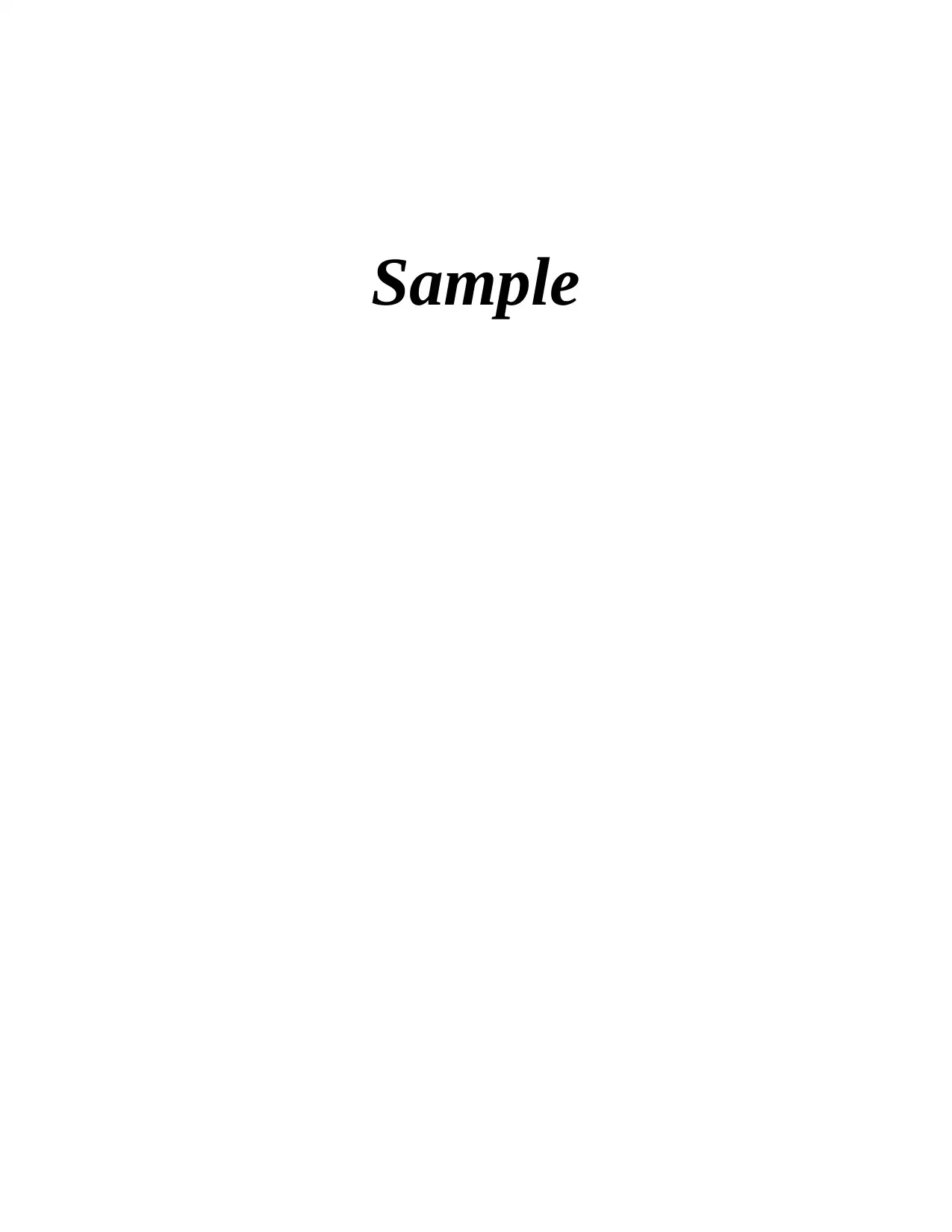
Sample
Paraphrase This Document
Need a fresh take? Get an instant paraphrase of this document with our AI Paraphraser
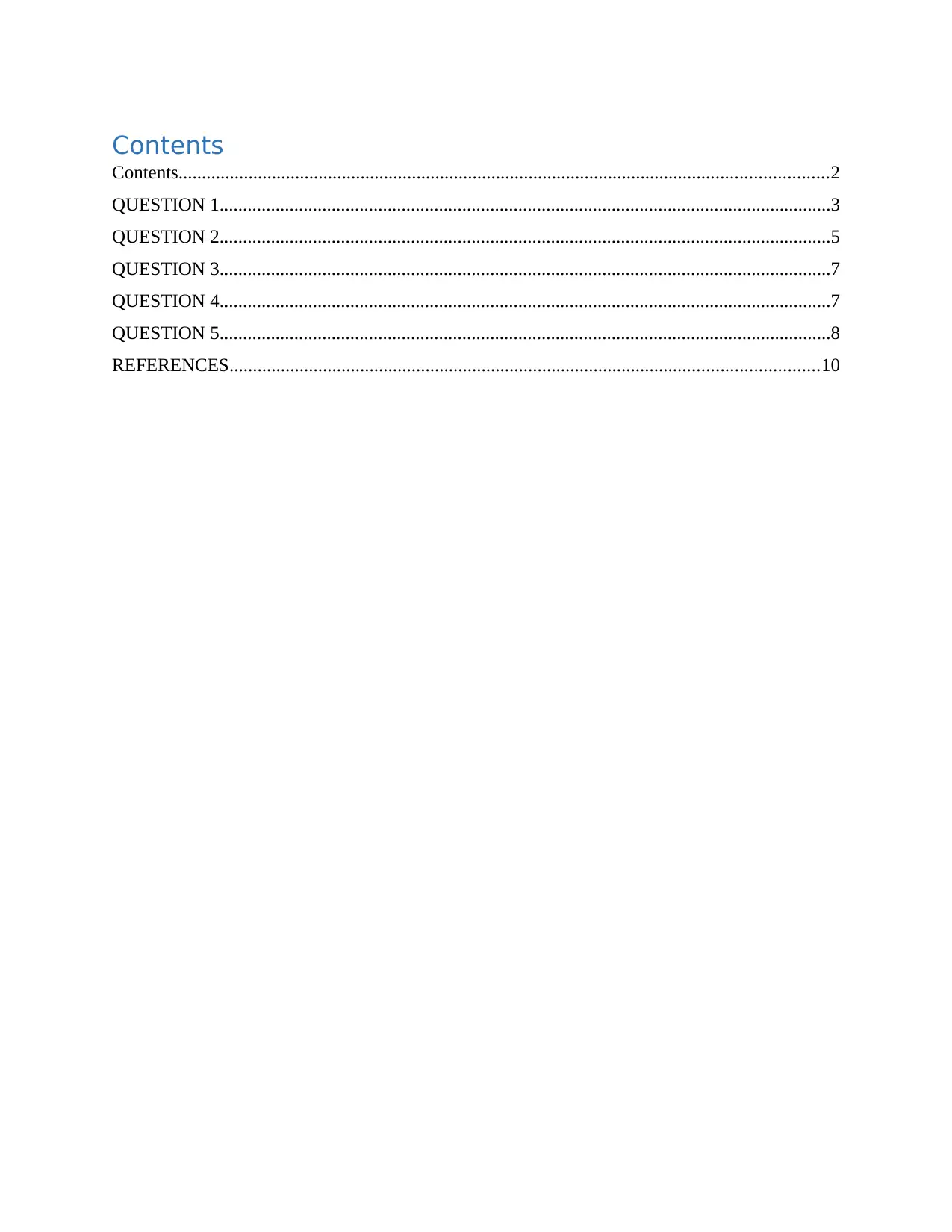
Contents
Contents...........................................................................................................................................2
QUESTION 1...................................................................................................................................3
QUESTION 2...................................................................................................................................5
QUESTION 3...................................................................................................................................7
QUESTION 4...................................................................................................................................7
QUESTION 5...................................................................................................................................8
REFERENCES..............................................................................................................................10
Contents...........................................................................................................................................2
QUESTION 1...................................................................................................................................3
QUESTION 2...................................................................................................................................5
QUESTION 3...................................................................................................................................7
QUESTION 4...................................................................................................................................7
QUESTION 5...................................................................................................................................8
REFERENCES..............................................................................................................................10
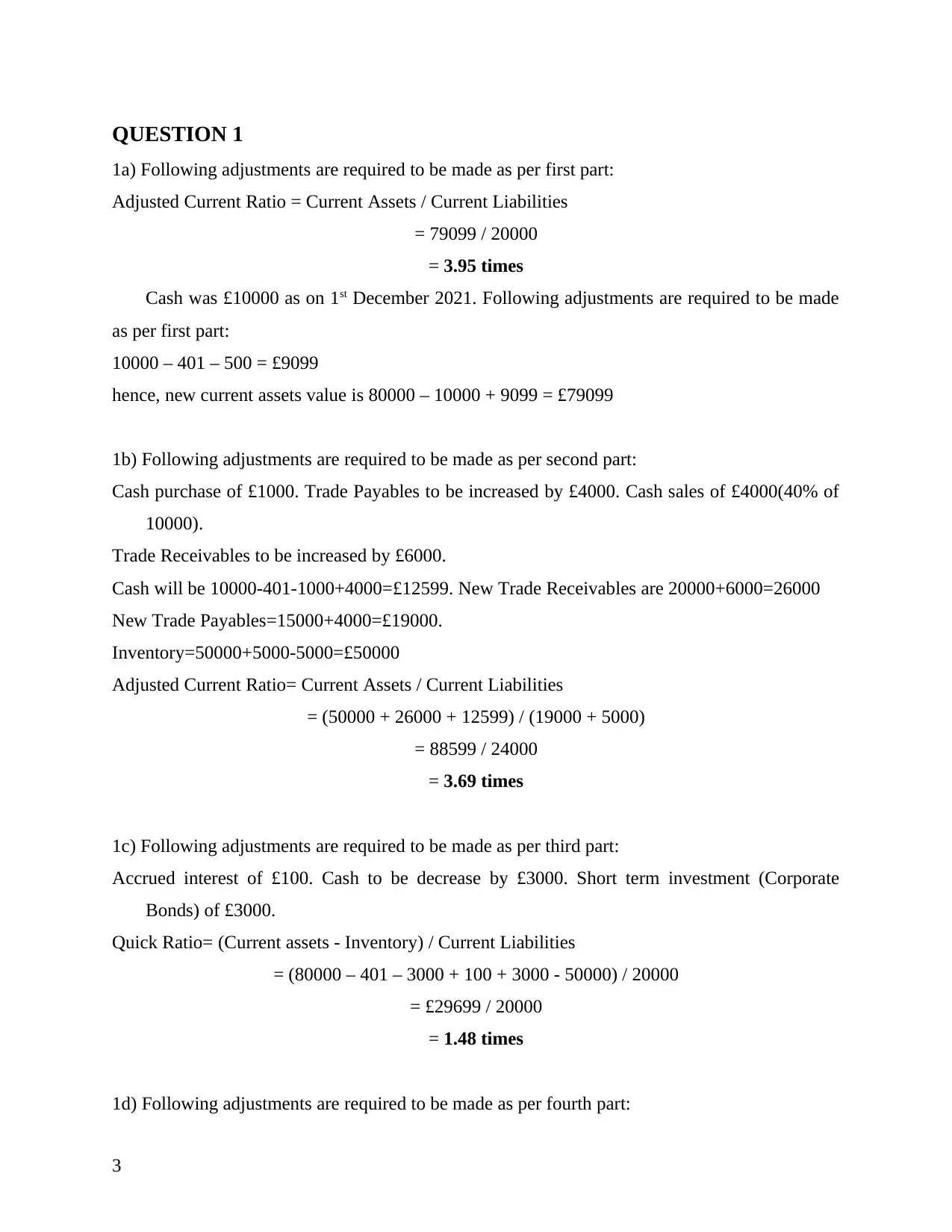
QUESTION 1
1a) Following adjustments are required to be made as per first part:
Adjusted Current Ratio = Current Assets / Current Liabilities
= 79099 / 20000
= 3.95 times
Cash was £10000 as on 1st December 2021. Following adjustments are required to be made
as per first part:
10000 – 401 – 500 = £9099
hence, new current assets value is 80000 – 10000 + 9099 = £79099
1b) Following adjustments are required to be made as per second part:
Cash purchase of £1000. Trade Payables to be increased by £4000. Cash sales of £4000(40% of
10000).
Trade Receivables to be increased by £6000.
Cash will be 10000-401-1000+4000=£12599. New Trade Receivables are 20000+6000=26000
New Trade Payables=15000+4000=£19000.
Inventory=50000+5000-5000=£50000
Adjusted Current Ratio= Current Assets / Current Liabilities
= (50000 + 26000 + 12599) / (19000 + 5000)
= 88599 / 24000
= 3.69 times
1c) Following adjustments are required to be made as per third part:
Accrued interest of £100. Cash to be decrease by £3000. Short term investment (Corporate
Bonds) of £3000.
Quick Ratio= (Current assets - Inventory) / Current Liabilities
= (80000 – 401 – 3000 + 100 + 3000 - 50000) / 20000
= £29699 / 20000
= 1.48 times
1d) Following adjustments are required to be made as per fourth part:
3
1a) Following adjustments are required to be made as per first part:
Adjusted Current Ratio = Current Assets / Current Liabilities
= 79099 / 20000
= 3.95 times
Cash was £10000 as on 1st December 2021. Following adjustments are required to be made
as per first part:
10000 – 401 – 500 = £9099
hence, new current assets value is 80000 – 10000 + 9099 = £79099
1b) Following adjustments are required to be made as per second part:
Cash purchase of £1000. Trade Payables to be increased by £4000. Cash sales of £4000(40% of
10000).
Trade Receivables to be increased by £6000.
Cash will be 10000-401-1000+4000=£12599. New Trade Receivables are 20000+6000=26000
New Trade Payables=15000+4000=£19000.
Inventory=50000+5000-5000=£50000
Adjusted Current Ratio= Current Assets / Current Liabilities
= (50000 + 26000 + 12599) / (19000 + 5000)
= 88599 / 24000
= 3.69 times
1c) Following adjustments are required to be made as per third part:
Accrued interest of £100. Cash to be decrease by £3000. Short term investment (Corporate
Bonds) of £3000.
Quick Ratio= (Current assets - Inventory) / Current Liabilities
= (80000 – 401 – 3000 + 100 + 3000 - 50000) / 20000
= £29699 / 20000
= 1.48 times
1d) Following adjustments are required to be made as per fourth part:
3
⊘ This is a preview!⊘
Do you want full access?
Subscribe today to unlock all pages.

Trusted by 1+ million students worldwide
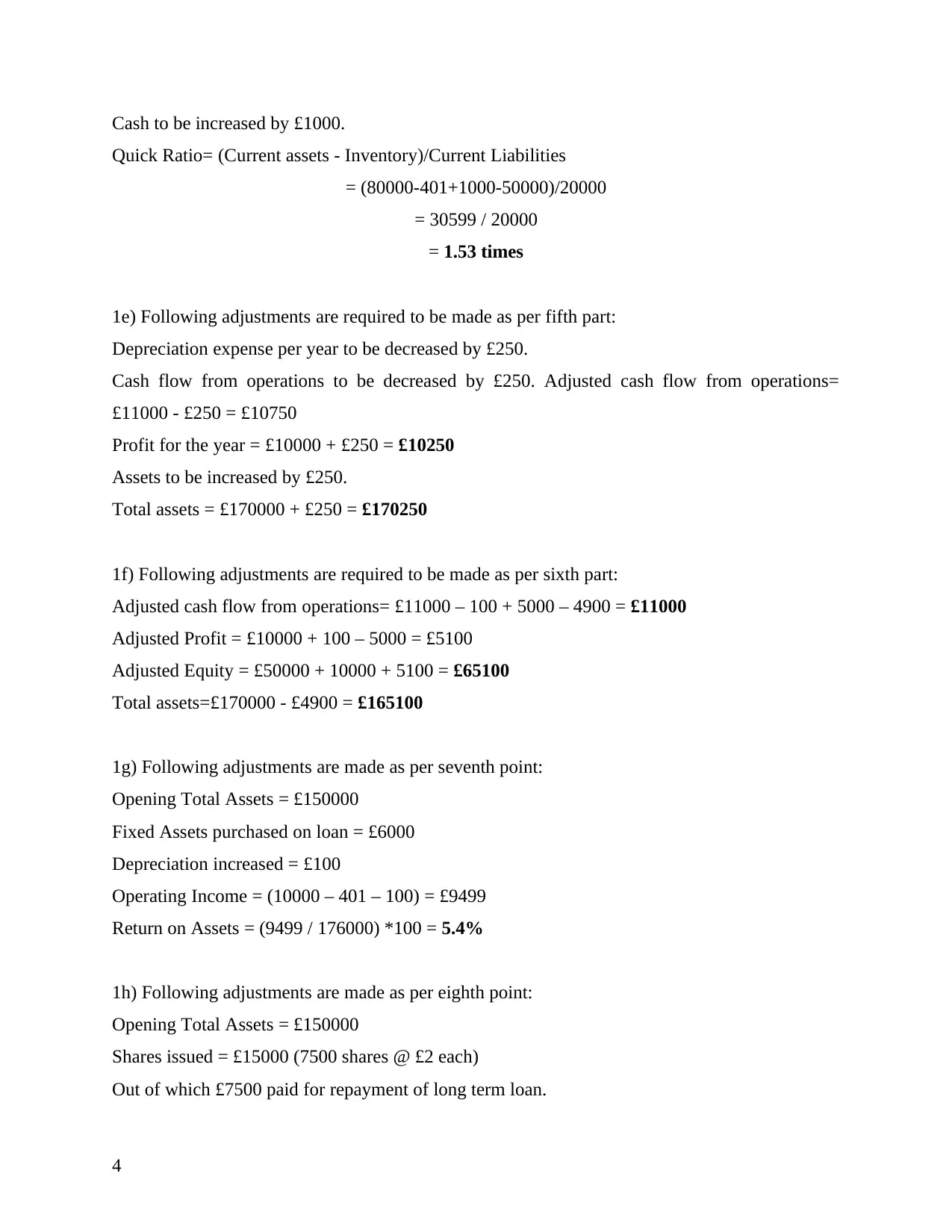
Cash to be increased by £1000.
Quick Ratio= (Current assets - Inventory)/Current Liabilities
= (80000-401+1000-50000)/20000
= 30599 / 20000
= 1.53 times
1e) Following adjustments are required to be made as per fifth part:
Depreciation expense per year to be decreased by £250.
Cash flow from operations to be decreased by £250. Adjusted cash flow from operations=
£11000 - £250 = £10750
Profit for the year = £10000 + £250 = £10250
Assets to be increased by £250.
Total assets = £170000 + £250 = £170250
1f) Following adjustments are required to be made as per sixth part:
Adjusted cash flow from operations= £11000 – 100 + 5000 – 4900 = £11000
Adjusted Profit = £10000 + 100 – 5000 = £5100
Adjusted Equity = £50000 + 10000 + 5100 = £65100
Total assets=£170000 - £4900 = £165100
1g) Following adjustments are made as per seventh point:
Opening Total Assets = £150000
Fixed Assets purchased on loan = £6000
Depreciation increased = £100
Operating Income = (10000 – 401 – 100) = £9499
Return on Assets = (9499 / 176000) *100 = 5.4%
1h) Following adjustments are made as per eighth point:
Opening Total Assets = £150000
Shares issued = £15000 (7500 shares @ £2 each)
Out of which £7500 paid for repayment of long term loan.
4
Quick Ratio= (Current assets - Inventory)/Current Liabilities
= (80000-401+1000-50000)/20000
= 30599 / 20000
= 1.53 times
1e) Following adjustments are required to be made as per fifth part:
Depreciation expense per year to be decreased by £250.
Cash flow from operations to be decreased by £250. Adjusted cash flow from operations=
£11000 - £250 = £10750
Profit for the year = £10000 + £250 = £10250
Assets to be increased by £250.
Total assets = £170000 + £250 = £170250
1f) Following adjustments are required to be made as per sixth part:
Adjusted cash flow from operations= £11000 – 100 + 5000 – 4900 = £11000
Adjusted Profit = £10000 + 100 – 5000 = £5100
Adjusted Equity = £50000 + 10000 + 5100 = £65100
Total assets=£170000 - £4900 = £165100
1g) Following adjustments are made as per seventh point:
Opening Total Assets = £150000
Fixed Assets purchased on loan = £6000
Depreciation increased = £100
Operating Income = (10000 – 401 – 100) = £9499
Return on Assets = (9499 / 176000) *100 = 5.4%
1h) Following adjustments are made as per eighth point:
Opening Total Assets = £150000
Shares issued = £15000 (7500 shares @ £2 each)
Out of which £7500 paid for repayment of long term loan.
4
Paraphrase This Document
Need a fresh take? Get an instant paraphrase of this document with our AI Paraphraser
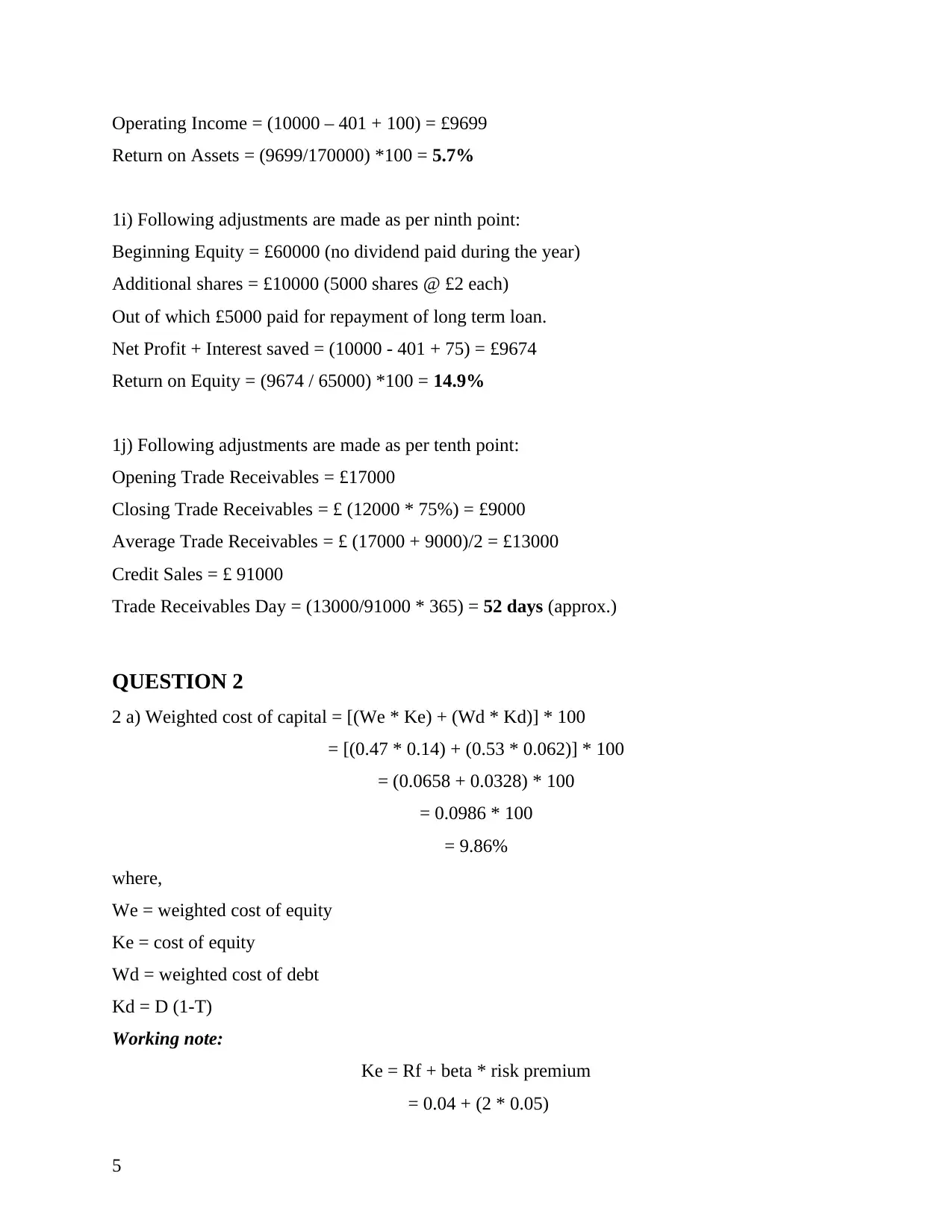
Operating Income = (10000 – 401 + 100) = £9699
Return on Assets = (9699/170000) *100 = 5.7%
1i) Following adjustments are made as per ninth point:
Beginning Equity = £60000 (no dividend paid during the year)
Additional shares = £10000 (5000 shares @ £2 each)
Out of which £5000 paid for repayment of long term loan.
Net Profit + Interest saved = (10000 - 401 + 75) = £9674
Return on Equity = (9674 / 65000) *100 = 14.9%
1j) Following adjustments are made as per tenth point:
Opening Trade Receivables = £17000
Closing Trade Receivables = £ (12000 * 75%) = £9000
Average Trade Receivables = £ (17000 + 9000)/2 = £13000
Credit Sales = £ 91000
Trade Receivables Day = (13000/91000 * 365) = 52 days (approx.)
QUESTION 2
2 a) Weighted cost of capital = [(We * Ke) + (Wd * Kd)] * 100
= [(0.47 * 0.14) + (0.53 * 0.062)] * 100
= (0.0658 + 0.0328) * 100
= 0.0986 * 100
= 9.86%
where,
We = weighted cost of equity
Ke = cost of equity
Wd = weighted cost of debt
Kd = D (1-T)
Working note:
Ke = Rf + beta * risk premium
= 0.04 + (2 * 0.05)
5
Return on Assets = (9699/170000) *100 = 5.7%
1i) Following adjustments are made as per ninth point:
Beginning Equity = £60000 (no dividend paid during the year)
Additional shares = £10000 (5000 shares @ £2 each)
Out of which £5000 paid for repayment of long term loan.
Net Profit + Interest saved = (10000 - 401 + 75) = £9674
Return on Equity = (9674 / 65000) *100 = 14.9%
1j) Following adjustments are made as per tenth point:
Opening Trade Receivables = £17000
Closing Trade Receivables = £ (12000 * 75%) = £9000
Average Trade Receivables = £ (17000 + 9000)/2 = £13000
Credit Sales = £ 91000
Trade Receivables Day = (13000/91000 * 365) = 52 days (approx.)
QUESTION 2
2 a) Weighted cost of capital = [(We * Ke) + (Wd * Kd)] * 100
= [(0.47 * 0.14) + (0.53 * 0.062)] * 100
= (0.0658 + 0.0328) * 100
= 0.0986 * 100
= 9.86%
where,
We = weighted cost of equity
Ke = cost of equity
Wd = weighted cost of debt
Kd = D (1-T)
Working note:
Ke = Rf + beta * risk premium
= 0.04 + (2 * 0.05)
5
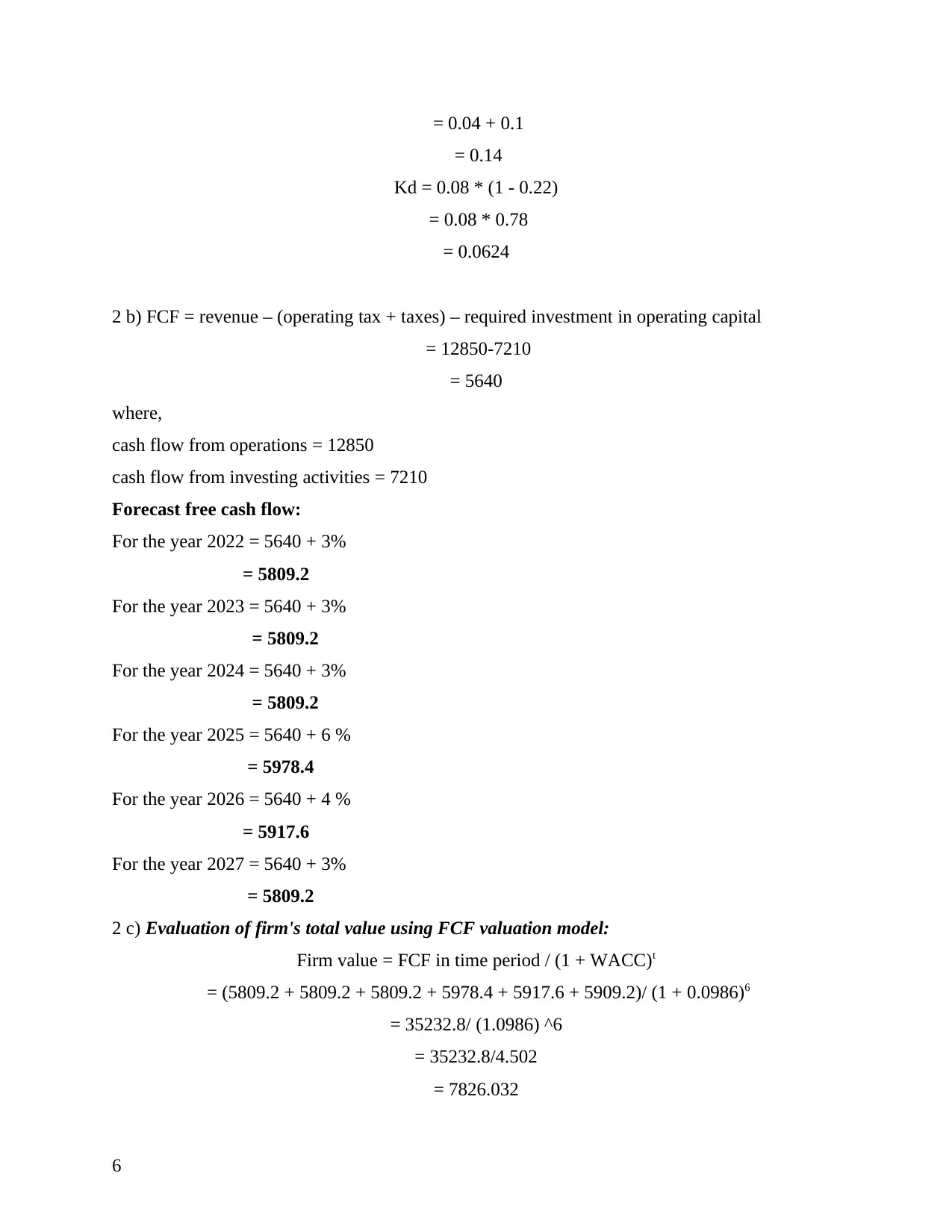
= 0.04 + 0.1
= 0.14
Kd = 0.08 * (1 - 0.22)
= 0.08 * 0.78
= 0.0624
2 b) FCF = revenue – (operating tax + taxes) – required investment in operating capital
= 12850-7210
= 5640
where,
cash flow from operations = 12850
cash flow from investing activities = 7210
Forecast free cash flow:
For the year 2022 = 5640 + 3%
= 5809.2
For the year 2023 = 5640 + 3%
= 5809.2
For the year 2024 = 5640 + 3%
= 5809.2
For the year 2025 = 5640 + 6 %
= 5978.4
For the year 2026 = 5640 + 4 %
= 5917.6
For the year 2027 = 5640 + 3%
= 5809.2
2 c) Evaluation of firm's total value using FCF valuation model:
Firm value = FCF in time period / (1 + WACC)t
= (5809.2 + 5809.2 + 5809.2 + 5978.4 + 5917.6 + 5909.2)/ (1 + 0.0986)6
= 35232.8/ (1.0986) ^6
= 35232.8/4.502
= 7826.032
6
= 0.14
Kd = 0.08 * (1 - 0.22)
= 0.08 * 0.78
= 0.0624
2 b) FCF = revenue – (operating tax + taxes) – required investment in operating capital
= 12850-7210
= 5640
where,
cash flow from operations = 12850
cash flow from investing activities = 7210
Forecast free cash flow:
For the year 2022 = 5640 + 3%
= 5809.2
For the year 2023 = 5640 + 3%
= 5809.2
For the year 2024 = 5640 + 3%
= 5809.2
For the year 2025 = 5640 + 6 %
= 5978.4
For the year 2026 = 5640 + 4 %
= 5917.6
For the year 2027 = 5640 + 3%
= 5809.2
2 c) Evaluation of firm's total value using FCF valuation model:
Firm value = FCF in time period / (1 + WACC)t
= (5809.2 + 5809.2 + 5809.2 + 5978.4 + 5917.6 + 5909.2)/ (1 + 0.0986)6
= 35232.8/ (1.0986) ^6
= 35232.8/4.502
= 7826.032
6
⊘ This is a preview!⊘
Do you want full access?
Subscribe today to unlock all pages.

Trusted by 1+ million students worldwide
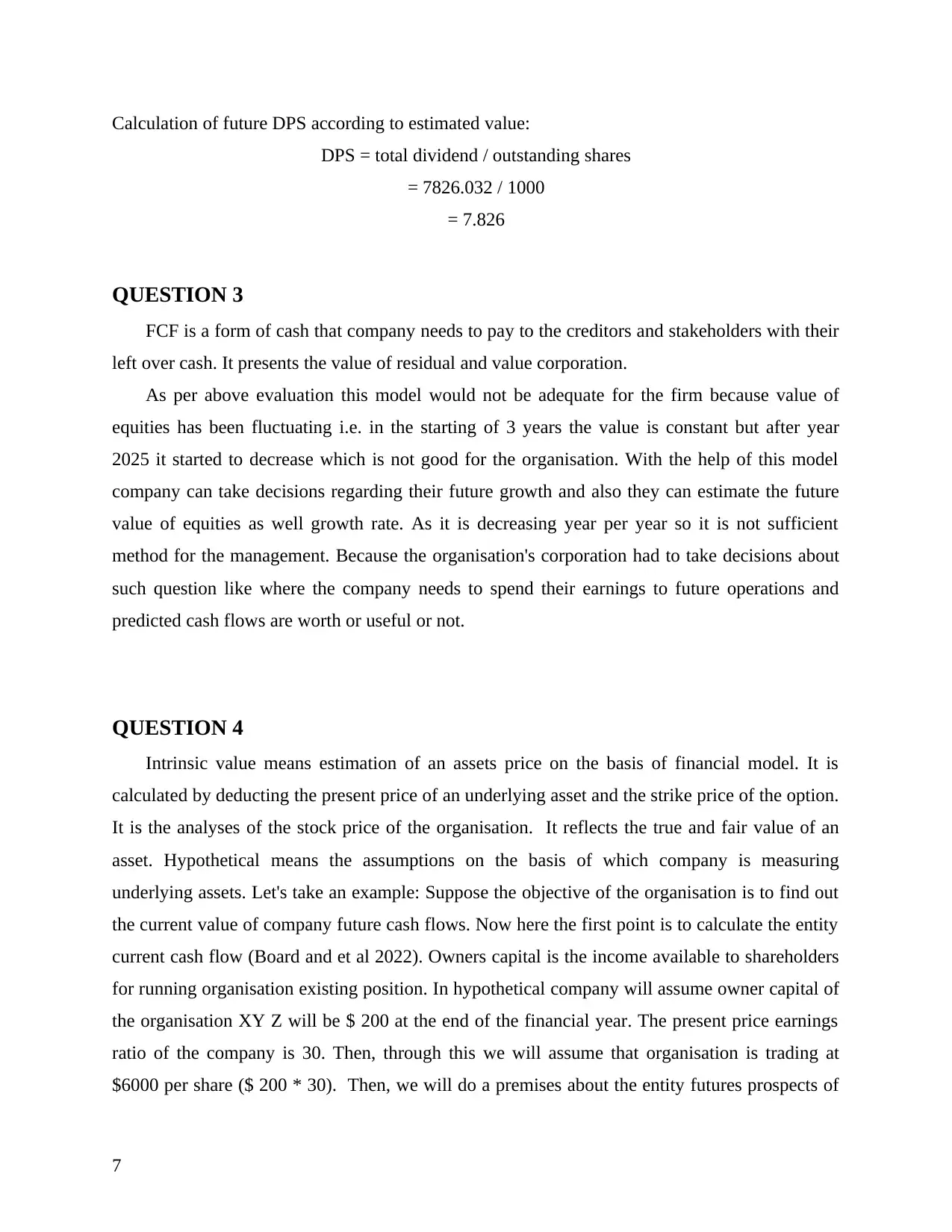
Calculation of future DPS according to estimated value:
DPS = total dividend / outstanding shares
= 7826.032 / 1000
= 7.826
QUESTION 3
FCF is a form of cash that company needs to pay to the creditors and stakeholders with their
left over cash. It presents the value of residual and value corporation.
As per above evaluation this model would not be adequate for the firm because value of
equities has been fluctuating i.e. in the starting of 3 years the value is constant but after year
2025 it started to decrease which is not good for the organisation. With the help of this model
company can take decisions regarding their future growth and also they can estimate the future
value of equities as well growth rate. As it is decreasing year per year so it is not sufficient
method for the management. Because the organisation's corporation had to take decisions about
such question like where the company needs to spend their earnings to future operations and
predicted cash flows are worth or useful or not.
QUESTION 4
Intrinsic value means estimation of an assets price on the basis of financial model. It is
calculated by deducting the present price of an underlying asset and the strike price of the option.
It is the analyses of the stock price of the organisation. It reflects the true and fair value of an
asset. Hypothetical means the assumptions on the basis of which company is measuring
underlying assets. Let's take an example: Suppose the objective of the organisation is to find out
the current value of company future cash flows. Now here the first point is to calculate the entity
current cash flow (Board and et al 2022). Owners capital is the income available to shareholders
for running organisation existing position. In hypothetical company will assume owner capital of
the organisation XY Z will be $ 200 at the end of the financial year. The present price earnings
ratio of the company is 30. Then, through this we will assume that organisation is trading at
$6000 per share ($ 200 * 30). Then, we will do a premises about the entity futures prospects of
7
DPS = total dividend / outstanding shares
= 7826.032 / 1000
= 7.826
QUESTION 3
FCF is a form of cash that company needs to pay to the creditors and stakeholders with their
left over cash. It presents the value of residual and value corporation.
As per above evaluation this model would not be adequate for the firm because value of
equities has been fluctuating i.e. in the starting of 3 years the value is constant but after year
2025 it started to decrease which is not good for the organisation. With the help of this model
company can take decisions regarding their future growth and also they can estimate the future
value of equities as well growth rate. As it is decreasing year per year so it is not sufficient
method for the management. Because the organisation's corporation had to take decisions about
such question like where the company needs to spend their earnings to future operations and
predicted cash flows are worth or useful or not.
QUESTION 4
Intrinsic value means estimation of an assets price on the basis of financial model. It is
calculated by deducting the present price of an underlying asset and the strike price of the option.
It is the analyses of the stock price of the organisation. It reflects the true and fair value of an
asset. Hypothetical means the assumptions on the basis of which company is measuring
underlying assets. Let's take an example: Suppose the objective of the organisation is to find out
the current value of company future cash flows. Now here the first point is to calculate the entity
current cash flow (Board and et al 2022). Owners capital is the income available to shareholders
for running organisation existing position. In hypothetical company will assume owner capital of
the organisation XY Z will be $ 200 at the end of the financial year. The present price earnings
ratio of the company is 30. Then, through this we will assume that organisation is trading at
$6000 per share ($ 200 * 30). Then, we will do a premises about the entity futures prospects of
7
Paraphrase This Document
Need a fresh take? Get an instant paraphrase of this document with our AI Paraphraser
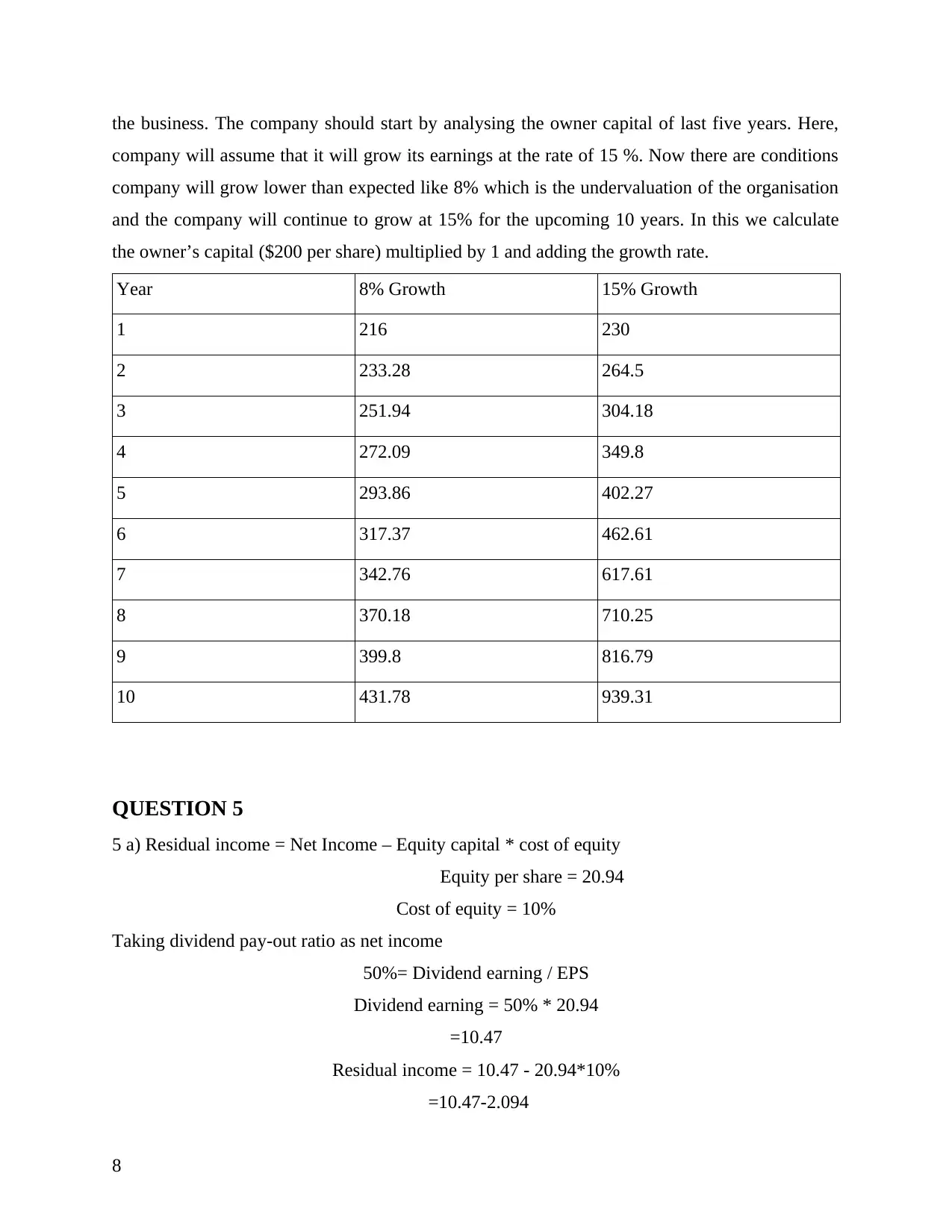
the business. The company should start by analysing the owner capital of last five years. Here,
company will assume that it will grow its earnings at the rate of 15 %. Now there are conditions
company will grow lower than expected like 8% which is the undervaluation of the organisation
and the company will continue to grow at 15% for the upcoming 10 years. In this we calculate
the owner’s capital ($200 per share) multiplied by 1 and adding the growth rate.
Year 8% Growth 15% Growth
1 216 230
2 233.28 264.5
3 251.94 304.18
4 272.09 349.8
5 293.86 402.27
6 317.37 462.61
7 342.76 617.61
8 370.18 710.25
9 399.8 816.79
10 431.78 939.31
QUESTION 5
5 a) Residual income = Net Income – Equity capital * cost of equity
Equity per share = 20.94
Cost of equity = 10%
Taking dividend pay-out ratio as net income
50%= Dividend earning / EPS
Dividend earning = 50% * 20.94
=10.47
Residual income = 10.47 - 20.94*10%
=10.47-2.094
8
company will assume that it will grow its earnings at the rate of 15 %. Now there are conditions
company will grow lower than expected like 8% which is the undervaluation of the organisation
and the company will continue to grow at 15% for the upcoming 10 years. In this we calculate
the owner’s capital ($200 per share) multiplied by 1 and adding the growth rate.
Year 8% Growth 15% Growth
1 216 230
2 233.28 264.5
3 251.94 304.18
4 272.09 349.8
5 293.86 402.27
6 317.37 462.61
7 342.76 617.61
8 370.18 710.25
9 399.8 816.79
10 431.78 939.31
QUESTION 5
5 a) Residual income = Net Income – Equity capital * cost of equity
Equity per share = 20.94
Cost of equity = 10%
Taking dividend pay-out ratio as net income
50%= Dividend earning / EPS
Dividend earning = 50% * 20.94
=10.47
Residual income = 10.47 - 20.94*10%
=10.47-2.094
8

=8.376
5 b) EPS for year 2023 = 3.92
Residual income is supposed to grow rate = 4%
Estimated growth rate for year 2024 = 3.92 +4%
= 4.0768
5 c) Market value of equity = 53
Expected value of equity = 53 + 4 (growth rate)
= 57
According to the case Harmon Plc, shows a good return in year 2024. from the current
scenario it can said that the company has undervalued its equity stocks. Company holds a great
competency and is a potential investment for Graham Plc, if acquired.
9
5 b) EPS for year 2023 = 3.92
Residual income is supposed to grow rate = 4%
Estimated growth rate for year 2024 = 3.92 +4%
= 4.0768
5 c) Market value of equity = 53
Expected value of equity = 53 + 4 (growth rate)
= 57
According to the case Harmon Plc, shows a good return in year 2024. from the current
scenario it can said that the company has undervalued its equity stocks. Company holds a great
competency and is a potential investment for Graham Plc, if acquired.
9
⊘ This is a preview!⊘
Do you want full access?
Subscribe today to unlock all pages.

Trusted by 1+ million students worldwide

REFERENCES
Books and Journals
Agyenim-Boateng, C., Stafford, A. and Stapleton, P., 2020. Does the United Kingdom’s Local
Improvement Finance Trust (LIFT) Scheme for Primary Health Care Enhance
Partnership Working?. Public Works Management & Policy, 25(3), pp.231-243.
Board, A.R and et.al 2022. Page numbers with an f indicate figures; those with a t indicate
tables; those with an n indicate endnotes.
Davis, M. and Davis, B., 2021. Crowdfunding and the Democratization of Finance. Policy Press.
Jones, A., 2018. Travelers’ Accounts as Sources. In Oxford Research Encyclopedia of African
History.
Just, S.N., Dahlman, S. and Mouton, N.T., 2021. Institutional fields as arenas of rhetorical
engagement: Convergence, conflict, and divergence between competing logics in the
field of finance. Communication Theory, 31(4). pp.696-713.
Kwilinski, A., 2019. Implementation of blockchain technology in accounting sphere. Academy
of Accounting and Financial Studies Journal, 23. pp.1-6.
Odintsova, T.Y.M., 2018. Chart of Accounts in the Context of the IFRS implementation and
Establishment of the Information Environment for Sustainable
Development. Accounting. Analysis. Auditing, 5(1).pp.56-67.
Tan, G.K.S., 2021. Democratizing finance with Robinhood: Financial infrastructure, interface
design and platform capitalism. Environment and Planning A: Economy and
Space, 53(8). pp.1862-1878.
Xin, C. and Yingxi, L., 2022. Factors influencing intentions to use library social media
marketing accounts: taking the example of WeChat. The Electronic Library, (ahead-of-
print).
Yue, J. and Wen, H., 2022. Can Digital Finance Contribute to the Optimization of Industrial
Structures: Empirical Evidence from Chinese 260 Cities. In International Conference on
Advanced Machine Learning Technologies and Applications (pp. 657-666). Springer,
Cham.
(V.Odintsova, 2018) (Tan, 2021) (Xin, and Yingxi, 2022) (Yue, and Wen, 2022)
10
Books and Journals
Agyenim-Boateng, C., Stafford, A. and Stapleton, P., 2020. Does the United Kingdom’s Local
Improvement Finance Trust (LIFT) Scheme for Primary Health Care Enhance
Partnership Working?. Public Works Management & Policy, 25(3), pp.231-243.
Board, A.R and et.al 2022. Page numbers with an f indicate figures; those with a t indicate
tables; those with an n indicate endnotes.
Davis, M. and Davis, B., 2021. Crowdfunding and the Democratization of Finance. Policy Press.
Jones, A., 2018. Travelers’ Accounts as Sources. In Oxford Research Encyclopedia of African
History.
Just, S.N., Dahlman, S. and Mouton, N.T., 2021. Institutional fields as arenas of rhetorical
engagement: Convergence, conflict, and divergence between competing logics in the
field of finance. Communication Theory, 31(4). pp.696-713.
Kwilinski, A., 2019. Implementation of blockchain technology in accounting sphere. Academy
of Accounting and Financial Studies Journal, 23. pp.1-6.
Odintsova, T.Y.M., 2018. Chart of Accounts in the Context of the IFRS implementation and
Establishment of the Information Environment for Sustainable
Development. Accounting. Analysis. Auditing, 5(1).pp.56-67.
Tan, G.K.S., 2021. Democratizing finance with Robinhood: Financial infrastructure, interface
design and platform capitalism. Environment and Planning A: Economy and
Space, 53(8). pp.1862-1878.
Xin, C. and Yingxi, L., 2022. Factors influencing intentions to use library social media
marketing accounts: taking the example of WeChat. The Electronic Library, (ahead-of-
print).
Yue, J. and Wen, H., 2022. Can Digital Finance Contribute to the Optimization of Industrial
Structures: Empirical Evidence from Chinese 260 Cities. In International Conference on
Advanced Machine Learning Technologies and Applications (pp. 657-666). Springer,
Cham.
(V.Odintsova, 2018) (Tan, 2021) (Xin, and Yingxi, 2022) (Yue, and Wen, 2022)
10
1 out of 10
Related Documents
Your All-in-One AI-Powered Toolkit for Academic Success.
+13062052269
info@desklib.com
Available 24*7 on WhatsApp / Email
![[object Object]](/_next/static/media/star-bottom.7253800d.svg)
Unlock your academic potential
Copyright © 2020–2025 A2Z Services. All Rights Reserved. Developed and managed by ZUCOL.





